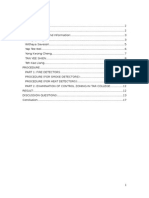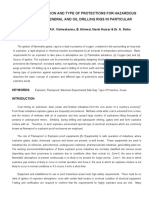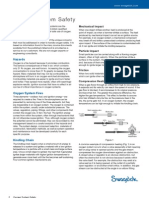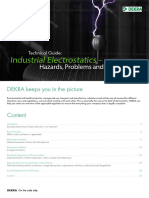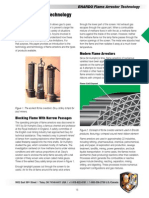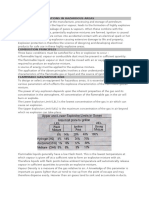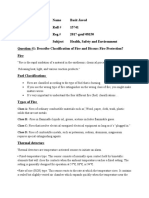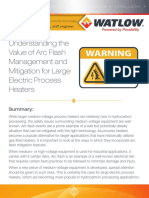Installation Guide For Hazardous Areas
Installation Guide For Hazardous Areas
Uploaded by
FraFraFra87Copyright:
Available Formats
Installation Guide For Hazardous Areas
Installation Guide For Hazardous Areas
Uploaded by
FraFraFra87Original Title
Copyright
Available Formats
Share this document
Did you find this document useful?
Is this content inappropriate?
Copyright:
Available Formats
Installation Guide For Hazardous Areas
Installation Guide For Hazardous Areas
Uploaded by
FraFraFra87Copyright:
Available Formats
Installation guide for hazardous areas
This installation guide should not be used as the controlling document for the installation of devices in a hazardous area. This guide is NOT A CONTROL DRAWING. Any installation of devices within a hazardous area as defined in the NEC MUST BE in accordance with that device's CONTROL DRAWING and local ordinances.
Table of contents
Acronyms, terms and definitions ...................................................................... 3 1.0 Introduction................................................................................................... 4 1.1 The fire triangle......................................................................................... 4 1.2 Fire loss control ........................................................................................ 5 1.3 The National Electrical Code ................................................................. 6 2.0 Hazardous areas and classifications .......................................................... 7 2.1 Class, Division and Zone .......................................................................... 7 2.2 Methods of protection ............................................................................... 9 2.2.1 Intrinsic safety.................................................................................. 10 2.2.1.1 Intrinsically safe apparatus entity parameters ............................ 11 2.2.2 Explosion proof ................................................................................ 13 2.2.3 Air purge .......................................................................................... 13 2.2.4 Other methods ................................................................................. 13 2.3 Class I, Division 2 locations .................................................................... 13 2.4 Wiring methods....................................................................................... 14 2.4.1 Intrinsically safe circuits ................................................................... 14 2.5 Marking examples .................................................................................. 15 3.0 Wiring Wilcoxon intrinsically safe sensors ............................................. 15 3.1 Dynamic vibration sensor wiring ............................................................. 15 3.1.1 Effects of barrier on bias output voltage (BOV)................................ 15 3.1.2 Troubleshooting ............................................................................... 17 3.2 LPS 4-20 mA sensor wiring .................................................................... 18 3.2.1 Troubleshooting the 4-20 mA LPS wiring......................................... 19 4.0 Technical assistance.................................................................................. 20 4.1 Technical and application assistance ..................................................... 20 4.2 Customer service.................................................................................... 20
Page 2 of 20
Acronyms CENELEC IEC NEC NFPA CSA IEPE European Committee for Electrotechnical Standardization International Electrotechnical Commission National Electric Code is a registered trademark of the National Fire Protection Association National Fire Protection Association Canadian Standards Association Integrated Electronic Piezo Electric (transducer)
Terms and definitions Sensor Power/signal Common , M Ignitable Flammable Combustion Combustible Dust Fiber Flyings Accelerometer or PiezoVelocity transducer (PVT) The connection to an IEPE sensor carrying the power and also the superimposed signal The return side of the IEPE circuit Ohm, Meg-Ohm (million Ohms) Any substance that can be burned Capable of being easily ignited and of burning quickly A usually rapid chemical process that produces heat and, often, light A mixture or substance that can be ignited to produce combustion Small particles of solid material that can be suspended in the air easily Thread-like material Small metal particles produced during machining, turning or grinding in metalworking
Page 3 of 20
1.0 Introduction The concept of intrinsic safety in wiring recognizes that ignitable, flammable or combustible materials will be present with air, or other oxidizer, in sufficient quantity and ratio so as to represent a fire or explosion hazard. These mixtures could easily be ignited by a match or other open flame, but just as easily could be ignited by a highenergy spark. Consequently, the wiring used in areas where these mixtures are present can be implemented in a fashion to absolutely preclude any possibility of igniting these mixtures. That is the essence of intrinsic safety! Intrinsically safe wiring will never have enough energy available within the hazardous defined area to ignite any explosive or combustible mixture. This concept is applied to mixtures of gasses, dusts, or metals. Where it is impossible to reduce the electrical circuit energy, as with electric motor power, then physical isolation of the circuits from the hazardous atmosphere, dust or metals is implemented. This is the principle behind explosion-proof wiring. Even if the circuit did ignite a quantity of hazardous mixture that intruded into the explosion-proof wiring, the wiring containment can contain the resulting explosion. Then, any escaping hot gasses will be cooled sufficiently so that they would be incapable of igniting any of the hazardous mixture outside of the explosion-proof conduit or fixtures. 1.1 The fire triangle Fuel and oxidizer must be present in a concentration appropriate to form a combustible mixture. The ignition source must supply enough energy to initiate combustion. It need not be a spark or a flame. Temperature alone can supply the energy of initiation. The fire triangle is a tool to illustrate that all three must be present to have a fire or explosion. If any one of the elements of the triangle is not present in sufficient amount, then combustion cannot occur. The availability of energy, by either thermal or electrical means, can cause the ignition of a combustible mixture. The energies required to ignite various groups of combustible substances have been proven by experimentation. Graphs of this data have been produced, and can be used to indicate safe levels of energy.
Page 4 of 20
A very small amount of energy is required to cause an ignition. For example, a mixture of hydrogen in air requires only 2O Joule of energy. In electrical circuits the mechanism for the release of this ignition energy is often a spark from a circuit wiring fault that creates a gap in the wire allowing a spark to form. Electrical components and equipment with hot surfaces also can cause ignition. The fuel component can be almost any substance. Most materials will burn if given the right temperature and pressure conditions. Fire is simply an oxidation process. Some oxidation processes proceed at a slow pace while fire is a rapid oxidation process. Steel rusts over a period of days, weeks, and months. If steel is finely granulated, placed in a pure oxygen environment, and then exposed to high temperatures, it will burn rapidly; almost like it was coal. Flour in a bakery can do the same thing as can the dust produced from grain stored in a grain elevator. While the oxidizer in most fires is oxygen, other chemicals may be oxidizers. For example, elemental magnesium will react violently with water to release heat. The magnesium is the fuel and water provides the oxidizer. Certain fuels, when combined with air, can form an explosive mixture. The main difference between a rapid fire and an explosion is that an explosion creates a pressure wave due to the rapid production of hot gas volume. That pressure wave is what is responsible for the "bang" associated with an explosion. The explosive pressure wave can cause serious damage to facilities and humans. 1.2 Fire loss control The concepts embodied in the fire triangle have been codified by various organizations. In the United States, one of the earliest organizations established was the predecessor of FM Global. In 1835 Zachariah Allen, a Rhode Island native and prominent textile mill owner, set out to reduce the insurance premium on his Rhode Island mill by making property improvements that would minimize the chance of fire loss1. Although widely accepted today, the concept of loss control was virtually unheard of at the time, but to Allen, a proactive approach to preventing losses before they occurred made good
http://www.fmglobal.com/corporate_info/history.html, April 2003 Page 5 of 20
economic sense. As Allen predicted, proper fire prevention methods, monitored by regular fire inspections for mill policyholders, resulted in fewer losses. As time went on, more and more companies realized the financial benefits of having their properties defined by their insurers as highly protected risks, or HPR properties. The mutual insurance companies worked with their policyholders to help them reduce their fire risks. One of the core methods used to do this was an analysis of the cause of the loss. Lessons learned were then applied to facilities of other policyholders to help them lessen the risk of fires. Eventually, the mutual insurance originally provided just to textile mills owners was expanded to include most other types of industrial facilities. As other types of industrial facilities became insured, the principles of loss control were applied to those companies. Insurers, today, regularly require facilities to use equipment that has been certified to comply with generally accepted standards for risk reduction. Carrying one or another of many such marks identifies equipment meeting such standards. Examples are Underwriters Laboratories, Inc. (UL), Factory Mutual (FM), and Canadian Standards Organization (CSA). 1.3 The National Electrical Code By the end of 1895, there were five different recognized standards in the United States that addressed the safe use of electrical equipment. Five different codes meant five different sets of rules for making an electrical installation. This, of course, created significant confusion and controversy. Something had to be done to produce a national code on a national scale. On a quest for solidarity, several national organizations held a meeting in New York on March 18, 1896, and named itself the "Joint Conference of Electrical and Allied Interests", to be chaired by W. J. Hammer. At this conference the five American Codes, together with the German Code, the Code of the British Board of Trade, and the Phoenix Rules of England, were discussed and referred to a committee with Professor Francis B. Crocker of Columbia University appointed as the chair. The committee selected the most suitable criteria from all the various codes, and after printing a draft code, it was sent to 1,200 interested individuals in North America and Europe for comment. The conference met again in May and June of 1897 and established an electrical code that was unanimously approved at the June meeting as the "National Code." Because it was so fair and broad in its application, it was adopted without delay by the National Board of Fire Underwriters in lieu of its own, and then
Page 6 of 20
issued by them as the "National Electrical Code of 1897". And thus, the "NEC" was born.2 In the United States today, the National Fire Protection Association (NFPA) publishes NFPA 70, National Electrical Code, also known as the NEC. The NFPA does not police or enforce compliance with the NEC. Neither do they certify, test or inspect products, designs, or installations for compliance. However, most states and localities within the U.S. cite the NEC as the authority controlling electrical installations. 2.0 Hazardous areas and classifications 2.1 Class, Division and Zone NEC Article 500 is entitled "Hazardous (Classified) Locations, Classes I, II, and III, Divisions 1 and 2." Articles 500 through 516 enumerate the various classifications and standards applicable to hazardous locations in the United States. Article 505, in particular, allows the use of the "Zone" system for flammable gasses, vapors, or liquids. Consequently, the Zone system does not apply to dust, fiber, or flyings.
Table 2.1.1 - Class location definitions
Table 2.1.2 Area location comparison, Class I NEC Zone versus Division locations
http://www.nfpa.org/itemDetail.asp?categoryID=524&itemID=18295&URL=Publications/necdigest/About%20the %20NEC/History, April 2006 Page 7 of 20
Hazardous locations are determined by the type of combustible material present, the extent of time it is present, and the physical construction of the area where such material is present. The presence of flammable gasses or vapors in quantities sufficient to produce an explosive or ignitable mixture constitutes a Class I location. A Class II location is characterized by combustible dust. Class III locations have easily ignitable fibers or flyings, but not suspended in the air in quantities sufficient to produce an ignitable airborne mixture. Division 1 locations, in general, are those areas where ignitable or flammable concentrations of combustible materials exist continuously or repeatedly during normal operations. Division 2 locations, in general, are those areas where such materials exist in ignitable or flammable concentrations only during periods of abnormal operating conditions.
Table 2.1.3 Apparatus grouping
Zone 0 locations, in general, are those areas where ignitable or flammable concentrations of combustible materials exist continuously or for long periods of time. Zone 1 locations, in general, are those areas where ignitable or flammable concentrations of combustible materials are likely to or frequently exist during normal operations. Zone 2 locations, in general, are those areas where ignitable or flammable concentrations of combustible materials are not likely to occur during normal operations or will exist for only a brief period of time. For all of these locations there are also various
a
Table 2.1.4 Temperature code/class for apparatus
Page 8 of 20
groups of gasses, vapors, dusts or fibers. The groups have been established based on the ignition energy required for each of the constituents within that group. The table below illustrates typical materials within each group and the group identification. All flammable materials have an ignition temperature. Even if the material is not exposed to an open flame or spark of a certain temperature, they will ignite if they are exposed to an object whose temperature exceeds the ignition temperature for that material. All apparatus designed for installation in hazardous areas are rated for their maximum surface temperature. Consequently, all apparatus have a temperature code associated with their hazardous area classification. The table below reflects the various temperature codes. 2.2 Methods of protection There are four basic principles to provide protection for hazardous area electrical circuit wiring. Prevent arcs, sparks and hot surfaces; prevent the combustible material from entering the space; contain any explosion of combustible material within the electric enclosure; or limit the energy available for sparks and hot surfaces. Methods of protection and their permitted use areas are summarized in table 2.2.1.
Table 2.2.1 Protection methods and permitted use for NEC
These protection methods are the methods permitted. NEC Article 500.8 (A) (1) (1) states that the suitability of identified equipment shall be determined from (1) the equipment listing or labeling, (2) evidence of equipment evaluation from a qualified testing laboratory or inspection agency concerned with product evaluation, or (3) evidence acceptable to the authority having jurisdiction such as a manufacturer's self-evaluation or an owner's engineering judgment. Subparagraph (2) states that equipment that has been identified for a Division 1 location shall be permitted in a Division 2 location of the same class and group.
Page 9 of 20
2.2.1 Intrinsic safety The National Electric Code defines an intrinsically safe circuit as a circuit in which any spark or thermal effect is incapable of causing ignition of a mixture of flammable or combustible material in air under prescribed test conditions. It also defines an intrinsically safe system as one that is an assembly of interconnected intrinsically safe apparatus, associated apparatus, and interconnecting cables in that those parts of the system that may be used in hazardous (classified) locations are intrinsically safe circuits3. Intrinsically safe apparatus have been tested to meet these requirements. The testing of the apparatus is designed to verify the operating parameters of the device and set the limits for its use in hazardous areas. In the typical intrinsically safe system for vibration transducers, the transducer is an approved device with an intrinsically safe circuit and is wired through an approved zener barrier device to the non-hazardous area. All wiring between the transducer and the barrier must also meet the requirements for hazardous (classified) area installation. Zener barrier devices limit the availability of energy to the wiring in the hazardous area. The figure here illustrates the internal schematic of a basic zener barrier. The zener diode in the center of the circuit acts to clamp the voltage available to the circuit in the hazardous area. Zener diodes are used because they have a very high resistance until the voltage rises to their conduction voltage. Once in conduction the Figure 2.2.1 - Basic zener barrier schematic diode "clamps" the voltage to a maximum value. It is this property of the zener diode that is exploited for use in instrumentation circuits in hazardous areas. The resistor, R, limits the maximum current available to the hazardous area circuit wiring. Since the voltage and the current are limited, the power is, therefore, also limited.
NEC Article 504.2, NFPA, 2002 Page 10 of 20
As an additional safety method, the barrier device also contains a fuse. The fuse will act to limit the current through the barrier circuit in the event that either the resistor or the zener should fault. WARNING: Wilcoxon transducers that carry approvals for intrinsically safe circuits must always be installed with safety barriers in the circuits for Class I Division 1, Zone 0 or Zone 1 areas. Simply buying a transducer that carries an intrinsically safe rating is not sufficient for permanently installed vibration transducers. Portable vibration analyzers or data collectors used within hazardous (classified) areas must also be rated for use within those areas. 2.2.1.1 Intrinsically safe apparatus entity parameters Earlier it was explained that an intrinsically safe system is composed of assembly of interconnected intrinsically safe apparatus, associated apparatus, and interconnecting cables. In the case of vibration sensors, the intrinsically safe apparatus is the sensor itself. The associated apparatus is the safety barrier. When the sensor is approved as intrinsically safe for use in hazardous areas, there are certain limitations placed upon it. The sensor cannot be connected to "any old" safety barrier. Rather, the barrier must have intrinsically safe ratings that are compatible with those of the sensor. Apparatus have four rating parameters: Voltage, Current, Capacitance, and Inductance. The open-circuit voltage available at the terminals of the barrier is Voc, or Vt. The shortcircuit current available at the terminals of the barrier is Isc, or It. The maximum capacitance that can be connected to the barrier apparatus is Ca while the maximum inductance that can be connected is La. The vibration sensor voltage rating, Vmax, is the maximum voltage that can be applied to the terminals of the sensor. The current rating, Imax, is the maximum current that can be applied through the terminals of the sensor. The value of internal capacitance, Ci, and inductance, Li, are also stated. When the sensor and barrier are connected together in a system, the cable capacitance, Ccable, and inductance, Lcable, must also be considered in the system.
Page 11 of 20
By comparing the ratings of the vibration sensors with those of the barrier and taking the cable values into account, an appropriate safety barrier can be selected. As long as the ratings satisfy the following equations, the system will meet the requirement for an intrinsically safe system. Voc (or Vt) must be equal to or less than Vmax Isc (or It) must be equal to or less than Imax Ca must be greater than or equal to Ci + Ccable La must be greater than or equal to Li + Lcable Voc Vmax Isc Imax Ca Ci + Ccable La Li + Lcable
Example The ratings for the 793E intrinsically safe rated accelerometer are: Vmax = 30 Vdc , Imax = 180 mA , Ci = 0.03 F, and Li = 0.00 mH and it limits the cable capacitance to 0.07 F. An MTL barrier such as the 7087 has the following parameters: Voc = 28 Vdc, Isc = 92 mA, Ca = 0.13 F, and La = 4.2 mH. If these devices are connected using 200 feet of the Wilcoxon J9T2A cable, it has a capacitance of 30 pF per foot. The cable capacitance is then 200 times 30 pF, equaling 0.006F. Now, let's put the numbers into the equations to see if these two devices are compatible for use as an intrinsically safe system. The equations, again, are stated here and the numbers substituted into the equation. If all the equations are satisfied as "True" the two devices can be used as an intrinsically safe system. Voc Vmax Isc Imax Ca Ci + Ccable La Li + Lcable 28 V 30 V 92 mA 180 mA 0.13 F 0.03 F + 0.006 F 4.2 mH 0.00 mH + 0.00 mH True True True True
Page 12 of 20
2.2.2 Explosion proof The principle behind explosion-proof transducers and wiring is that any ignition of flammable material that occurs within the transducer or wiring will be contained. The hot gasses and flames will not be allowed to escape into the hazardous area and further propagate the fire or explosion. All circuit wiring is run in conduit and junction boxes approved for explosion-proof installation. Explosion proof transducers and wiring must be installed according to ANSI/UL 12031994, Explosion-Proof and Dust-Ignition-Proof Electrical Equipment for Use in Hazardous (Classified) Locations. 2.2.3 Air purge When installations are not explosion proof or intrinsically safe, pressurization is often used to maintain the classified area safety. Wiring and enclosures are protected using a positive air pressure maintained within the enclosure, junction boxes and conduit. The concept of pressurization protection is covered under ANSI/NFPA 496-1998, Purged and Pressurized Enclosures for Electrical Equipment. 2.2.4 Other methods Flameproof (d), increased safety (e), encapsulation (m), oil immersion (o), dust ignition proof, dust tight, powder filled (q), non-sparking (n), non-incendive, and hermetically sealed are other levels of protection. Each is used where appropriate for electrical circuit wiring. Many of them apply to AC powered circuits, but few are used for instrumentation circuit wiring. 2.3 Class I, Division 2 locations In the United States, section 500 of the NEC specifically cites hermetic sealing as a protective method allowed for Class I, Division 2 areas. Hermetically sealed accelerometers can be installed in Class I, Division 2 locations. Accelerometers do not have to be specifically marked as suitable for Division 2 locations. General purpose equipment that is operated in Class I areas must be marked with a temperature code if they have surfaces that rise above 100C when operating in an ambient temperature of 40C. Since Wilcoxon accelerometers do not rise above 100C in an ambient temperature of 40C, they do not require marking.
Page 13 of 20
The governing judgment as to the acceptability of accelerometers for installation is in section 500.8. It cites the following as an item of guidance for determining the suitability of equipment for installation, "Evidence acceptable to the authority having jurisdiction such as a manufacturer's self-evaluation or an owner's engineering judgment." ANSI/ISA12.12.012000, Nonincendive Electrical Equipment for Use in Class I and II, Division 2 and Class III, Divisions 1 and 2 Hazardous (Classified) Locations states in the Scope, paragraph 2.5, "This standard is not intended to cover equipment for use in Class I and Class II, Division 1 locations, such as equipment constructed to be intrinsically safe, dust ignition-proof, or explosion-proof. Such equipment is, however, suitable for use in Class I and Class II, Division 2 locations in the same group for which it is suitable in Division 1." 2.4 Wiring methods 2.4.1 Intrinsically safe circuits The NEC Article 504 controls the wiring of intrinsically safe circuits. It generally requires that intrinsically safe circuits be physically separated from nonintrinsically safe circuits. Conductors and cables of intrinsically safe circuits not in raceways or cable trays shall be separated at least 50 mm (2 inches) and secured from conductors and cables of any non-intrinsically safe circuits. Conductors of intrinsically safe circuits can only be placed in the same raceway or cable tray with non-intrinsically safe circuits when the intrinsically safe circuits are separated by a distance of 50 mm (2 inches) or by a grounded metal partition or approved insulating partition. The 50 mm separation of circuits also applies to the wiring within enclosures. Intrinsic safety barriers have their input and output terminals separated by 50 mm because of the spacing requirement. The input wiring of the enclosure where the barriers are installed must maintain the required 50 mm physical separation between the intrinsically safe circuits and the non-intrinsically safe circuits. Most barrier manufacturers offer special mounting hardware to label the circuits and keep the isolation required between the input and output wiring.
Page 14 of 20
2.5 Marking examples Intrinsically safe rated transducers will have the information regarding the Class, Division or Zone, Group, and Temperature ratings engraved directly on the sensor case. Illustrated here is the engraving from a Wilcoxon Research 793E accelerometer. The engraving also indicates the installation control document number (WR 90546) shipped with all intrinsically safe sensors. 3.0 Wiring Wilcoxon intrinsically safe sensors 3.1 Dynamic vibration sensor wiring The 793-series, 797-series, and 766-series vibration sensors have approvals for hazardous area intrinsically safe installation. Acceleration output, velocity output, and low frequency capability sensors are available within these series of sensors. These sensors are all considered Integrated Electronic Piezoelectric (IEPE) sensors. They are powered using a constant-current diode or similar Field Effect Transistor (FET) based powering system. 3.1.1 Effects of barrier on bias output voltage IEPE sensors have an output that is a combination of the DC bias output voltage (BOV) and the superimposed vibration signal. The BOV is controlled by the sensor design and exists as long as the current source provides adequate current. The sensor generally needs at least 1 mA of current. It is common to use current values of 2 to 4 mA for the constant-current source. When IEPE sensors are used in intrinsically safe circuits, the effects of the zener safety barrier must be considered in the sensor operating circuit. It is possible to use a barrier that provides a safe circuit, but precludes the proper operation of the sensor.
a
Figure 3.1.1.1 - Barrier schematic
Illustrated here is the package outline for the MTL 7778ac barrier. It has four wiring connections. Terminals 1 & 2 are the safe area connections and terminals 3 & 4 are the hazardous area terminal connections. An intrinsically safe rated accelerometer, such as the Wilcoxon 793E, would be connected
Page 15 of 20
to terminals 3 & 4. This diagram illustrated the earth ground of the barrier in the center of the array of Zener diodes. The 793E will be connected across terminals 3 & 4 in the circuit. The manufacturing specification of the 793E calls for its BOV not to exceed 13.5 volts. If the 793E is powered using a constantcurrent diode value of 4 mA, then the resistors will each cause a voltage drop of 2.4 volts (600 x .004). The total voltage drop across the barrier and the 793E could then be as high as 18.3 volts (13.5+2.4+2.4) and will appear to be the BOV of the accelerometer as viewed across terminals 1 Figure 3.1.1.2 - Circuit voltages & 2 of the barrier. This is the effective maximum BOV that would be seen by an analyzer connected to this circuit and using a powering current of 4 mA. Since the accelerometer should allow for a maximum voltage to be 2 volts less than the open-circuit supply voltage, a BOV of 18.3 volts means that the dynamic signal can only go 3.7 volts positively before entering this "forbidden zone" of operation. That means the effective positive dynamic signal is limited to 37g's (3.7 volts @ 100 mV/g). If the 793E had its nominal BOV of 12 volts, then the BOV seen at the output of the MTL7778ac would be about 16.8 volts and the positive-going dynamic range would be 5.2 volts, or about 52g's. The diagram illustrated here shows the wiring for the 793E accelerometer. Shielded, twisted pair wire is used throughout. The connector at the accelerometer must connect
Figure 3.1.1.3 - 793E wiring example
the shield of the shielded, twisted pair wire to the case of the 793E. However, the shield
Page 16 of 20
should not be connected to ground at the barrier or an electrical ground loop will be created in the shield circuit. The shield on the output of the barrier should also not be connected at the barrier for the same reason. The barrier, itself, will be connected to an earth ground as required by the NEC. 3.1.2 Troubleshooting Improper wiring of Wilcoxon sensors will result in a loss of signal or excessive noise in the signal. There are some simple steps that can verify proper installation. All troubleshooting described here using an ohmmeter is conducted with the circuit "deenergized" so as not to confuse the readings. If the proper reading is not indicated, the user must take action to determine why that connection is not correct. The most common wiring faults are reversed wires and ground loops. Reversed wires are where the power/signal and the common wire get reversed. Ground loops are formed when there is more than one circuit path to ground. The shields should connect to ground at only one point and that must be verified. Wilcoxon has special connectors that will connect the shield to the case of a 2-pin sensor. These are the R6Q and the R6SL connectors. These connectors are designed with a conductive spring inside the shell of the connector that makes contact with the neck of the connector to provide an electrical connection of the shield to the case of a 793-series or 797-series sensor. The 766-series sensors have a third pin on their connector (pin "C") that internally connects to the case of the 766. Wilcoxon cables are wired with a black wire in all shielded, twisted pair cables. The black wire is the common in the circuit and connects to pin "B" of the connector of the sensor. The wire for the "power/signal" connection will either be red or white and connects to pin "A" of the sensor. Both the "A" and "B" pins of the sensor are isolated from ground. Ohmmeter readings between either pin "A" and the case or pin "B" and the case should give a high ohmic reading (over 10 M). On the 766, the reading between pin "C" and the case should be less than 1. With the sensor installed on the machine, the cable connected and the output terminated in the junction box or data acquisition system, the integrity of the shield/ground connection can be tested. The safety barrier will be grounded to a good earth ground (as required by the NEC) and the shields can be tested there to verify they connect to ground. The resistance between each wire's shield and the ground at the barrier should be less than 10. Verify that the shields are not connected to any circuit or ground at the
Page 17 of 20
barrier. Then, go to the sensor and remove the connector. The resistance between the shield and the machine case should be over 10 M. Re-connect the cable to the sensor. At the junction box or data acquisition equipment, disconnect the wire (plug) from the input panel. The resistance between the shield and the ground connection should be over 10 M. Re-connect the cable to the input.
3.2 4-20 mA loop powered sensor (LPS) wiring The wiring for intrinsically safe loop powered sensors (such as Wilcoxon models PC420Axx-yy-IS and PC420Vxx-yy-IS) will be the same. The connector at the LPS should be an isolated type of connector where the shield does not connect to the case. The Wilcoxon R6W, R6QI, or R6SLI can be used. They all have the shield isolated from the transducer case at the sensor connection.
Figure 3.2 LPS Series wiring
In the installation of the LPS intrinsically safe units it is important to avoid ground loops in the shield circuit wiring. The illustration here shows how the shields should be connected to avoid the possibility of ground loops. The shield at the LPS should be isolated from connecting to the case. The shield of the cable from the LPS should connect to ground at the barrier. The signal output cable from the barrier should not connect to ground at the barrier, but must be connected to ground at the PLC or DCS.
Page 18 of 20
Wilcoxon recommends an MTL7087+, or equivalent, safety barrier. The MTL7087+ barrier has the following parameters: Voc = 28 Volts, Isc = 93 mA. The LPS Series transducers have the following parameters: Vmax = 30 Vdc, Imax = 106 mA. The LPS Series transducer and the associated safety barrier must satisfy the following equations to be used together. Equation Voc Vmax Isc Imax LPS compared to 7087+ 28 V 30 V 93 mA 106 mA Result True True
Since the relationship between the parameters satisfy the equations, the MTL7087+ can be used with the LPS Series transducers in a Class 1, Division 1 (or Zone 0), Group A gas hazardous area installation. However, the user must also follow the guidelines for the 7087+ as to the maximum allowable capacitance in the cable. The 7087+ lists the maximum capacitance as 0.13 F. The Wilcoxon J9T2A cable has 0.00003 F per foot of cable. Therefore it would take more than 4,000 feet of J9T2A cable to exceed the capacitance limits imposed by the 7087+.
3.2.1 Troubleshooting the 4-20 mA LPS Wiring WARNING: All troubleshooting work performed on an intrinsically safe wiring installation in a hazardous area should be conducted under a "Hot Work" permit under the guidelines for permits in your plant. If diagnostics are performed using a "Cold Work" permit, the Multimeter used for circuit measurements MUST BE rated for use in a hazardous area. An example of the loop wiring using an MTL7087+ is illustrated here in figure 3.2.1.1. The shield of the hazardous area wiring connects to terminal "6" of the 7087+. Check the shielding in a manner similar to that in the dynamic sensor section of this document.
Figure 3.2.1.1 - MTL7087+ wiring illustration
Figure 3.2.1.2 illustrates that terminal "6" is directly connected to the earth ground through the 7087+ barrier. The +24 Volt DC power for the LPS transducer connects to
Page 19 of 20
terminal "1" and the power connection to the transducer if off terminal "4". The return signal from the LPS transducer connects to terminal "5". Between terminal "5" and "2" is a diode that restricts the signal to allow current flow only from the hazardous area, but not to flow to the hazardous area. If the power and return were accidentally switched at the input to the barrier (power to "2" and return to "1", there would be no current flowing in the circuit. The loop current would be "zero." Likewise, if the wiring to the LPS is reversed (power to pin "B" and return to pin "A") there will be no current allowed to flow in the circuit due to the protective diodes installed in the LPS Series intrinsically safe transducers. 4.0 Technical assistance
Figure 3.2.1.2 - 7087+ schematic
4.1 Technical and application assistance For technical or application assistance, please contact Wilcoxons Application Engineering at 301-330-8811, FAX to 301-330-8873, or email to techasst@wilcoxon.com. 4.2 Customer service To obtain additional technical reports or sales support, please contact customer service at 301-330-8811, or fax to 301-330-8873.
Page 20 of 20
You might also like
- Installation Guide Hazardous Areas 2010Document17 pagesInstallation Guide Hazardous Areas 2010Muntasir SNo ratings yet
- P&F ATEX Physical PrinciplesDocument48 pagesP&F ATEX Physical PrinciplesMilkNo ratings yet
- Electrical Equipment in Hazardous Areas - WikiDocument6 pagesElectrical Equipment in Hazardous Areas - Wikis kNo ratings yet
- Hazardous Area ClassificationDocument9 pagesHazardous Area ClassificationyogitatanavadeNo ratings yet
- Electrical Equipment in Hazardous AreasDocument10 pagesElectrical Equipment in Hazardous Areasperumal1312No ratings yet
- Electrical Equipment in Hazardous AreasDocument5 pagesElectrical Equipment in Hazardous AreasCARLOS MIGLIARONo ratings yet
- Hazardous Zone, Class, DivisionDocument26 pagesHazardous Zone, Class, DivisionHạo Nam-Born To WinNo ratings yet
- Electrical Equipment in Hazardous Areas - Wikipedia, The Free EncyclopediaDocument6 pagesElectrical Equipment in Hazardous Areas - Wikipedia, The Free EncyclopediaajayNo ratings yet
- Electrical Equipment in Hazardous AreasDocument14 pagesElectrical Equipment in Hazardous Areasger80No ratings yet
- Hazardous Area & Temp ClassificationDocument12 pagesHazardous Area & Temp Classificationsatyajit_naibNo ratings yet
- Explosion Protection Theory and Practice - Phoenix ContactDocument40 pagesExplosion Protection Theory and Practice - Phoenix Contactcuongphan123No ratings yet
- Ex Protection TypesDocument37 pagesEx Protection Typesbrkygnr100% (1)
- Hazardous Area Classification BasicsDocument20 pagesHazardous Area Classification Basicssohelazam90% (10)
- AtexDocument60 pagesAtexWendi Junaedi100% (2)
- Understanding Hazardous Locations: An Ebook By: Pepperl+Fuchs, The Intrinsic Safety ExpertsDocument19 pagesUnderstanding Hazardous Locations: An Ebook By: Pepperl+Fuchs, The Intrinsic Safety Experts04422236558No ratings yet
- Electrical Equipment in Hazardous AreasDocument13 pagesElectrical Equipment in Hazardous AreasedwinNo ratings yet
- Electrical Equipment in Hazardous Areas - Wikipedia, The Free EncyclopediaDocument12 pagesElectrical Equipment in Hazardous Areas - Wikipedia, The Free EncyclopediaMrNo ratings yet
- P&F ATEX Types of ProtectionDocument48 pagesP&F ATEX Types of ProtectionMilkNo ratings yet
- Basic Concepts For Explosion ProtectionDocument47 pagesBasic Concepts For Explosion Protectionjahehe2000No ratings yet
- Vent CollectDocument26 pagesVent CollectipliprensNo ratings yet
- Principles of Explosion Protection 30080001258Document68 pagesPrinciples of Explosion Protection 30080001258HoangNo ratings yet
- Fire Alarm ReportDocument18 pagesFire Alarm ReportWong Lipping0% (1)
- Electrical Engineering Portal - Com Substation Fire ProtectionDocument4 pagesElectrical Engineering Portal - Com Substation Fire ProtectionJaeman ParkNo ratings yet
- Guide To Hazardous AreasDocument15 pagesGuide To Hazardous AreasMudassir Mirza100% (1)
- Basics of Explosion and Type of Protections For Hazardous Locations in General and Oil Drilling Rigs in ParticularDocument9 pagesBasics of Explosion and Type of Protections For Hazardous Locations in General and Oil Drilling Rigs in ParticularKartik JoshiNo ratings yet
- 1.2.5 AbhiyamDocument16 pages1.2.5 AbhiyamAbhiyam MauryaNo ratings yet
- Introto Fire Det TechnologyDocument64 pagesIntroto Fire Det TechnologyAlejandra AriasNo ratings yet
- 04_Flame ArrestersDocument5 pages04_Flame ArrestersNice OrioleNo ratings yet
- Oxygen System SafetyDocument4 pagesOxygen System Safetychianqiao100% (1)
- Oxygen System Safety (MS-06-13)Document4 pagesOxygen System Safety (MS-06-13)herysyam1980No ratings yet
- Allen Bradley Class Division Hazardous LocationDocument26 pagesAllen Bradley Class Division Hazardous LocationcloobpspNo ratings yet
- dekra-technical-guide-industrial-electrostatic-hazardsDocument32 pagesdekra-technical-guide-industrial-electrostatic-hazardsAbu IlyasNo ratings yet
- Fire Performance of Electric Cables White PaperDocument16 pagesFire Performance of Electric Cables White PaperkeyurNo ratings yet
- Flame ArrestorDocument14 pagesFlame ArrestorVishnu Teja100% (1)
- Electrical Equipment in Hazardous AreasDocument8 pagesElectrical Equipment in Hazardous AreasMehulkumar PatelNo ratings yet
- EEP Types and Origins of Substation Fires ArticleDocument7 pagesEEP Types and Origins of Substation Fires ArticleAlbertoKrawczykNo ratings yet
- FLAMEPROOF AREA - DATADocument11 pagesFLAMEPROOF AREA - DATASUSHIL HIBARENo ratings yet
- Weighing SystemDocument7 pagesWeighing SystemIndranil HatuaNo ratings yet
- Techniques Used To Reduce Explosion Hazards-Snehashis BoseDocument4 pagesTechniques Used To Reduce Explosion Hazards-Snehashis BoseSnehashis BoseNo ratings yet
- Fire and Explosion Characteristics of Powders: Vahid Ebadat, PH.DDocument7 pagesFire and Explosion Characteristics of Powders: Vahid Ebadat, PH.Dsiruslara6491No ratings yet
- Explosion Protection and Intrinsic Safety 1012Document25 pagesExplosion Protection and Intrinsic Safety 1012ArdvarkNo ratings yet
- BasitDocument13 pagesBasitTalha ranaNo ratings yet
- Immediate download Handbook of Energy Engineering Energy Engineering and Systems 8th Edition D. Paul Mehta ebooks 2024Document81 pagesImmediate download Handbook of Energy Engineering Energy Engineering and Systems 8th Edition D. Paul Mehta ebooks 2024nailikriozzi100% (3)
- Ex ProtectionDocument47 pagesEx Protection2zece100% (1)
- Understanding The Value of Arc Flash Management and Mitigation For Large Electric Process HeatersDocument5 pagesUnderstanding The Value of Arc Flash Management and Mitigation For Large Electric Process HeatersLiu YangtzeNo ratings yet
- Vetrivel Training Institute Fire MQP AnswersDocument6 pagesVetrivel Training Institute Fire MQP AnswersMurali Dharma Raja PraphuNo ratings yet
- Dust Explosion and Fire Prevention Handbook: A Guide to Good Industry PracticesFrom EverandDust Explosion and Fire Prevention Handbook: A Guide to Good Industry PracticesNo ratings yet
- The Risks of Nuclear Energy Technology: Safety Concepts of Light Water ReactorsFrom EverandThe Risks of Nuclear Energy Technology: Safety Concepts of Light Water ReactorsNo ratings yet
- Fatigue Assessment in Light Water Reactors for Long Term Operation: Good Practices and Lessons LearnedFrom EverandFatigue Assessment in Light Water Reactors for Long Term Operation: Good Practices and Lessons LearnedNo ratings yet
- Management of Disused Ionization Chamber Smoke Detectors: Approaches and Practical ExperiencesFrom EverandManagement of Disused Ionization Chamber Smoke Detectors: Approaches and Practical ExperiencesNo ratings yet
- The Art of Welding: Practical Information and Useful Exercises for Oxyacetylene and Electric Arc WeldingFrom EverandThe Art of Welding: Practical Information and Useful Exercises for Oxyacetylene and Electric Arc WeldingNo ratings yet
- Polymers for Electricity and Electronics: Materials, Properties, and ApplicationsFrom EverandPolymers for Electricity and Electronics: Materials, Properties, and ApplicationsNo ratings yet
- Applicability of IAEA Safety Standards to Non-Water Cooled Reactors and Small Modular ReactorsFrom EverandApplicability of IAEA Safety Standards to Non-Water Cooled Reactors and Small Modular ReactorsNo ratings yet





















